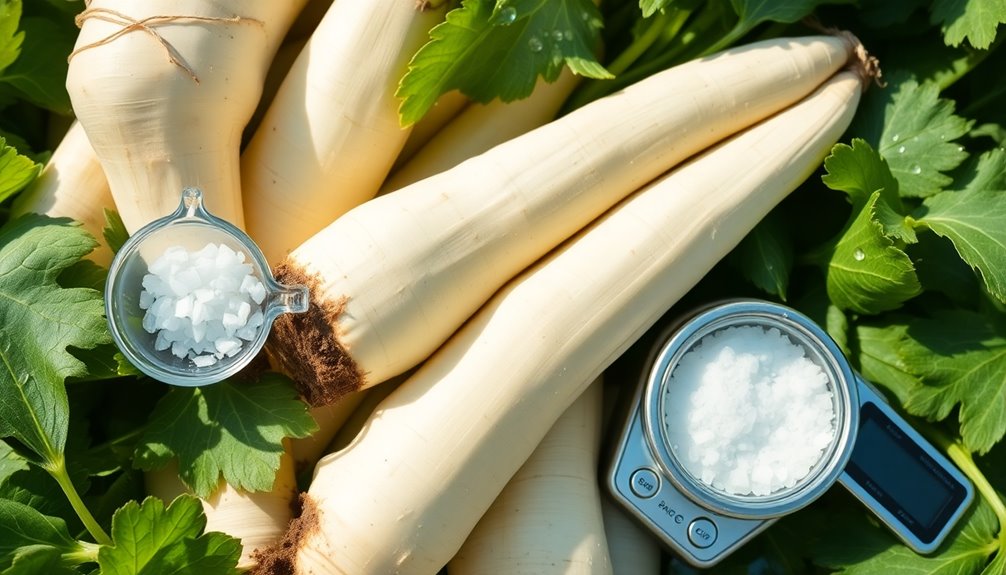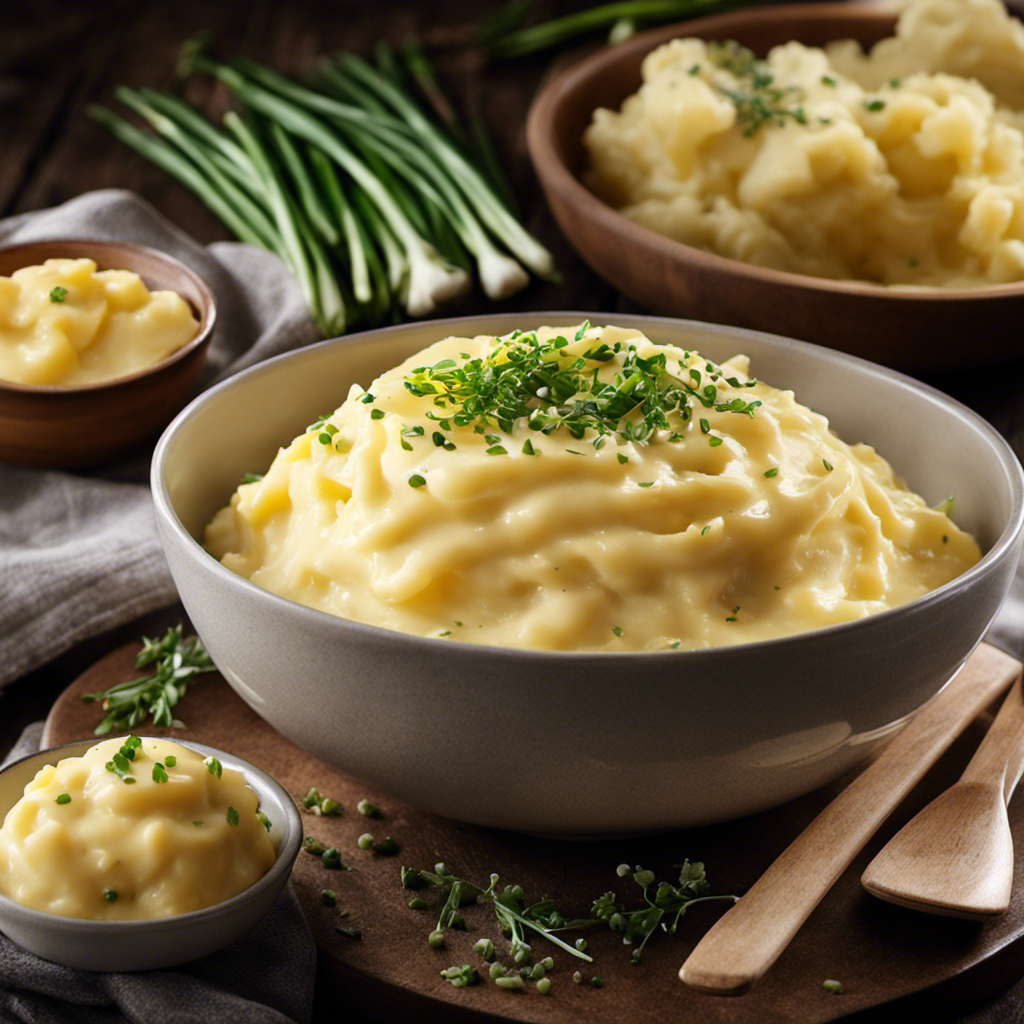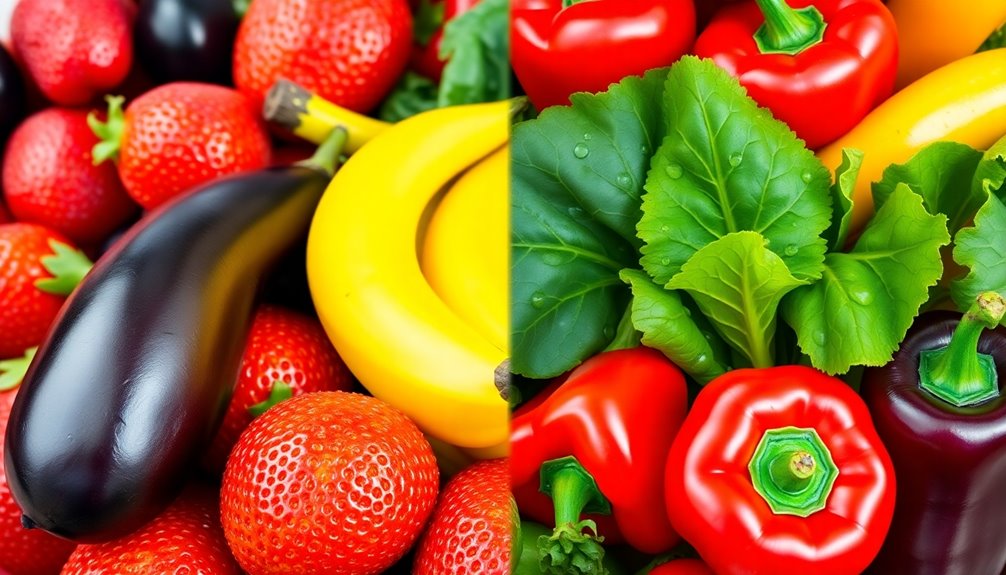When it comes to net carbs, parsnips have about 13.1 grams per 100-gram serving after accounting for fiber. This means you're looking at around 20.8 grams of net carbs in a full cup. While they're nutritious, with beneficial vitamins and fiber, their moderate glycemic index (around 97) makes portion control essential if you're on a low-carb diet. To keep your carb intake in check, consider combining them with lower-carb veggies like cauliflower or zucchini. By doing so, you can enjoy their unique flavor without going overboard on carbs. There's more to explore about parsnips and their culinary possibilities.
Key Takeaways
- Parsnips contain approximately 18 grams of total carbohydrates per 100 grams, yielding about 13.1 grams of net carbs after accounting for fiber.
- A 1-cup serving (161 grams) has around 26.5 grams of total carbs and approximately 20.8 grams of net carbs.
- The moderate glycemic index of parsnips (around 97) can impact blood sugar levels, necessitating portion control.
- For low-carb diets, consider alternatives like cauliflower, zucchini, or turnips, which have significantly lower net carb counts.
- Creative cooking methods, such as roasting or steaming, can enhance flavor while managing carbohydrate content in meals.
What Are Parsnips?

Parsnips, nature's sweet root vegetable, are closely related to carrots and potatoes, boasting a unique nutty flavor that elevates numerous dishes. Originating in Eurasia, these vegetables have been cultivated for centuries and were once used as a sweetener before sugar became widely available.
When you include parsnips in your meals, you'll enjoy not only their distinctive taste but also their impressive nutritional profile. In a 100-gram serving of parsnips, you'll find about 18 grams of carbohydrates and 4.9 grams of fiber, which supports digestive health.
While parsnips are a delicious addition to your diet, it's crucial to note their carbohydrate content. They've a higher net carb count compared to many other root vegetables, making them less suitable for strict low-carb diets. Additionally, parsnips possess a high glycemic index, which means they can cause a quicker rise in blood sugar levels.
However, they're also packed with Vitamin C, Vitamin K, and potassium, all of which contribute to immune function, bone health, and heart health. Including parsnips in your diet can also provide antioxidants that combat oxidative stress, further enhancing their nutritional benefits.
Carbs in Parsnips
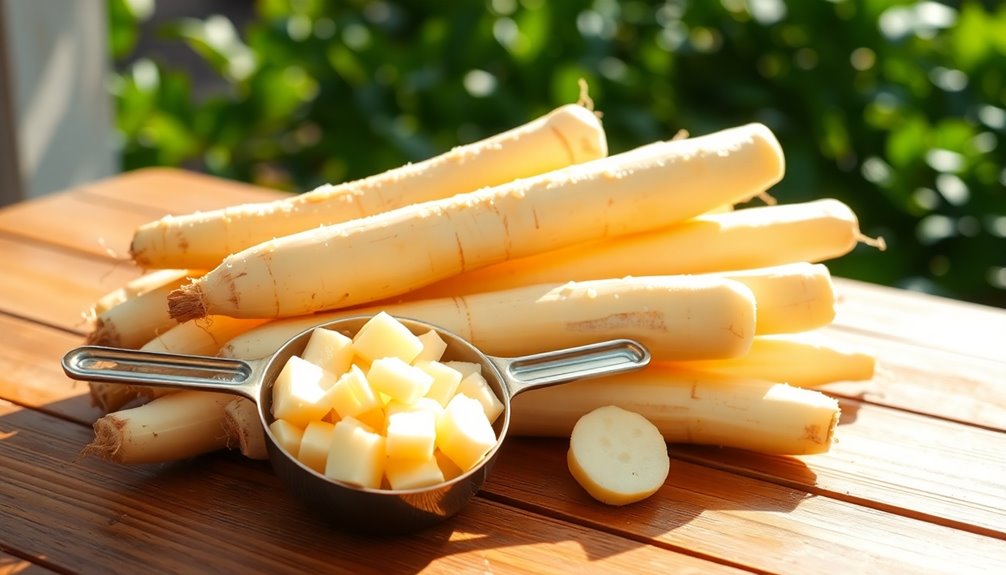
Understanding the carbohydrate content in parsnips is vital for anyone mindful of their dietary choices. A 100-gram serving of parsnips contains about 18 grams of total carbs, with 4.9 grams of fiber. This means the net carb count is roughly 13.1 grams, which you get by subtracting the fiber from the total carbs.
If you opt for a 1-cup serving, around 161 grams, you'll consume about 26.5 grams of total carbs, translating to approximately 20.8 grams of net carbs.
For those on ketogenic diets or closely monitoring their carbohydrate intake, it's significant to highlight that parsnips have a moderate glycemic index. This can affect your blood sugar levels, so portion control becomes vital.
While delicious and nutritious, parsnips have a higher carbohydrate content compared to other root vegetables, which may make them less suitable for strict low-carb diets. If you're looking to enjoy parsnips, be mindful of your serving size to keep your net carb intake in check.
Nutritional Value Overview
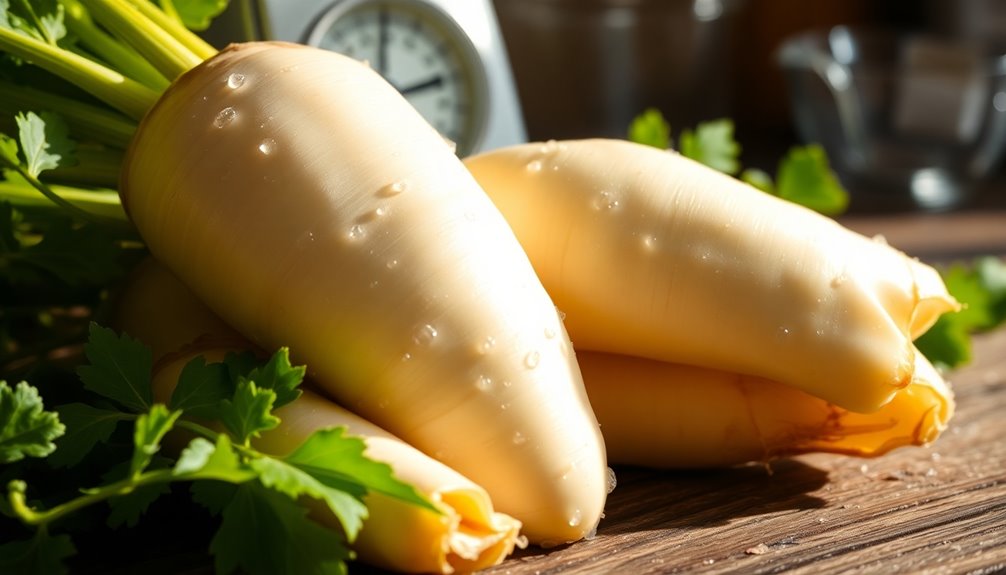
When you consider the nutritional value of parsnips, you'll find they offer a variety of essential vitamins and minerals that contribute to a balanced diet. A 100-gram serving of parsnips contains about 18 grams of total carbohydrates, with 4.9 grams of dietary fiber. This fiber is vital for digestive health and can help you feel full.
Regarding net carbs, parsnips have approximately 13.1 grams per 100-gram serving, making them a moderate-carb option.
Parsnips also shine with their vitamin and mineral content. You'll get 20.1 mg of Vitamin C, which supports your immune system, along with 571.6 mg of potassium, important for heart health. Additionally, they provide 6.4 mcg of Vitamin K, essential for bone health and proper blood clotting.
If you're following a low-carb diet, it's good to know that parsnips have a moderate glycemic index. This means they can fit into your meal plan, but be sure to consume them in moderation to manage your overall carb content effectively. Additionally, incorporating parsnips into your diet can help provide essential nutrients that support overall health and wellness.
Embracing the nutritional value of parsnips can enhance your meals while keeping your diet balanced.
Understanding Net Carbs

When you hear the term "net carbs," it refers to the carbohydrates that actually affect your blood sugar levels after accounting for fiber.
Knowing how to calculate net carbs is essential if you're following a low-carb or ketogenic diet, as it helps you manage your intake effectively.
Understanding this concept will empower you to make better choices, especially when considering foods like parsnips.
Definition of Net Carbs
Net carbs represent the carbohydrates that your body can actually digest and use for energy, making them vital for those monitoring their carb intake. To calculate net carbs, you simply subtract fiber from total carbohydrates. This method gives you a clearer picture of the carbs affecting your blood sugar levels.
For instance, a 100-gram serving of parsnips contains about 18 grams of total carbohydrates, but with roughly 4.9 grams of fiber, you end up with around 13.1 grams of net carbs.
Understanding net carbs is important if you're following a low-carb diet or ketogenic diets, as it helps you track your carbohydrate intake more effectively. While parsnips are nutritious, their higher net carb count compared to many other vegetables means you'll need to be mindful of portion sizes to stay within your daily limits.
This is particularly important for those managing blood sugar levels, as the moderate glycemic index of parsnips can impact your overall health. By keeping an eye on net carbs, you can better navigate your dietary choices and maintain a balanced approach to your nutrition.
Importance in Dieting
Understanding the significance of net carbs is vital for anyone looking to manage their diet effectively. When you're on a low-carb or ketogenic diet, keeping track of net carbs helps you stay within your daily carb limit.
Parsnips contain approximately 13.1 grams of net carbs per 100-gram serving, making them relatively higher in carbohydrates compared to other low-carb alternatives. A standard serving of parsnips, about 1 cup or 161 grams, has around 20.8 grams of net carbs, which can impact your dietary choices.
If you're following a strict low-carb plan, you might want to limit your intake of parsnips due to their potential to spike blood sugar levels. While they can be included in a relaxed low-carb diet, portion control is vital to guarantee you don't exceed your daily carb limit.
It's smart to combine parsnips with lower-carb vegetables to create balanced meals that align with your dietary goals. By understanding net carbs, you can make informed choices, guaranteeing you're not only enjoying your meals but also supporting your health objectives effectively. Additionally, incorporating age-appropriate discipline methods can help you maintain a healthy lifestyle for the entire family.
Calculating Net Carbs
Calculating net carbs is vital for anyone managing their carbohydrate intake, especially if you're on a low-carb or ketogenic diet. To determine net carbs, you simply subtract the fiber content from the total carbohydrates in a food item. This gives you a more accurate measure of carbohydrates that affect your blood sugar levels.
For instance, in a 100-gram serving of parsnips, you'll find around 17.99 grams of total carbohydrates and 4.9 grams of fiber. When you do the math, that results in approximately 13.09 grams of net carbs. Understanding these numbers is essential, particularly for those monitoring their glycemic index, as parsnips have a moderate rating that can influence how quickly their carbohydrates are digested and absorbed.
When calculating net carbs, pay attention to portion sizes. Larger servings can greatly increase your total net carb consumption, making it easy to exceed your daily limit.
Parsnips on Low Carb Diets

If you're following a low-carb diet, you might want to think twice before adding parsnips to your plate. While they offer some beneficial nutrients like Vitamin C and potassium, parsnips pack around 13.09 grams of net carbs per 100-gram serving.
If you opt for a 1-cup serving, you're looking at roughly 20.8 grams of net carbs, which can be a considerable portion of your daily limit on a strict keto diet.
For those on strict low-carb diets, parsnips mightn't be the best choice. Their moderate glycemic index and higher carb content can make it challenging to stay within your carb limits.
While you can include parsnips on a relaxed low-carb plan, you'll need to practice portion control to avoid exceeding your daily carb allowance.
It's important to remember that environmental interactions can influence dietary choices and preferences, which may impact your overall health and well-being.
If you're aiming for keto-friendly alternatives, consider options like cauliflower or zucchini, which offer considerably lower net carb counts.
These vegetables can help you maintain your low-carb goals without the risk of derailing your diet. So, when it comes to parsnips on a keto plan, you may want to think again before adding them to your meals.
Parsnips and Keto Diets

Parsnips may seem like a wholesome addition to your meals, but they don't align well with keto diets. Their carbohydrate content can complicate your goals. With approximately 13.1 grams of net carbs per 100-gram serving, parsnips can quickly eat into your daily carbohydrate limit, especially since strict keto diets typically restrict net carbs to 20-50 grams per day.
A single cup of parsnips packs around 20.8 grams of net carbs, which could consume nearly your entire daily allowance. This can lead to spikes in blood sugar, given their glycemic index of around 97.
While they offer beneficial vitamins and minerals, their carb content makes them less keto-friendly compared to alternatives like cauliflower and zucchini, which only have about 3 grams of net carbs each.
If you're following a relaxed low-carb diet, you might include parsnips in moderation, but keep a close eye on your serving size. Portion control is essential to guarantee you don't exceed your daily carbohydrate limits.
For those committed to a strict keto lifestyle, it's probably best to steer clear of parsnips to maintain stability in your dietary regimen.
Health Benefits of Parsnips

While parsnips may not be the best choice for a keto diet, they do offer a variety of health benefits when included in a balanced diet. One standout feature is their fiber content, providing about 4.9 grams per 100 grams. This fiber aids in digestive health and helps you feel fuller longer, making it easier to manage your overall food intake.
Parsnips are also a fantastic source of Vitamin C, with 17.0 mg per 100 grams. This vitamin supports your immune function and contributes to healthy skin, making it a great addition to your diet.
Additionally, they contain Vitamin K, which is crucial for bone health—providing 23 µg per 100 grams.
Potassium is another essential mineral found in parsnips, offering around 375 mg per 100 grams. It helps regulate blood pressure and supports heart health.
Plus, their moderate glycemic index allows for better blood sugar management compared to higher GI foods. By incorporating parsnips into your meals, you can enjoy these health benefits while adding variety to your diet.
Cooking Methods and Impact

When you cook parsnips, the method you choose can greatly affect their flavor and nutritional profile.
Roasting brings out their sweetness, while steaming and boiling can help manage their glycemic impact.
Let's explore the best techniques for preparing parsnips and how each one influences their net carb content.
Roasting Techniques Explained
Roasting parsnips is a fantastic way to release their natural sweetness and nutty flavor, transforming them into a delightful side dish. To get the best results, it's important to cut the parsnips into uniform pieces, ensuring they cook evenly in the oven. Toss them in olive oil, salt, and your favorite herbs or spices for added flavor.
Here's a quick guide to roasting parsnips:
| Step | Description |
|---|---|
| Temperature | Preheat your oven to 400°F (200°C). |
| Cooking Time | Roast for 25-35 minutes, depending on size. |
| Turning | Flip the parsnips halfway through for even browning. |
| Mix-ins | Add carrots or sweet potatoes for a colorful medley. |
As the parsnips roast, they'll caramelize, creating a crispy exterior while remaining tender inside. This method enhances their natural flavor, making each bite a tasty experience. So fire up your oven and enjoy a delicious side dish that pairs well with numerous meals!
Steaming Benefits Highlighted
Steaming parsnips offers multiple benefits that enhance both their flavor and nutritional profile. This cooking method effectively retains the nutritional value of parsnips, preserving vitamins like Vitamin C and essential minerals while minimizing nutrient loss. By opting for steaming, you can enjoy parsnips' natural sweetness and nutty flavor without needing to add sugars, making them more palatable.
Additionally, steamed parsnips have a lower glycemic index compared to fried or roasted varieties, which is essential for blood sugar management. This means they can help maintain steady energy levels, making them a smart choice for those mindful of their carb intake.
Steaming also softens the fiber in parsnips, promoting better digestion and aiding in satiety, which can support your weight management goals. With approximately 4.9 grams of fiber per 100 grams, steamed parsnips contribute to improved digestive health and regularity.
Incorporating steamed parsnips into your meals can be a delicious and nutritious way to enjoy this versatile root vegetable while reaping the benefits of fiber and ideal nutrient retention.
Boiling vs. Frying
Cooking methods greatly influence the nutritional value and health benefits of parsnips. When you choose between boiling and frying, it's crucial to take into account their impact on the glycemic index and carbohydrate levels. Here's a quick comparison to help you decide:
| Cooking Method | Glycemic Index | Nutritional Impact |
|---|---|---|
| Boiling | ~52 | Preserves more vitamins, lower calories |
| Frying | Higher | Increases calories, potential nutrient loss |
Boiling parsnips generally results in a lower glycemic index (GI), making them a better choice for blood sugar management. The average GI of boiled parsnips is around 52, whereas frying can spike the GI considerably, leading to quicker digestion and potential blood sugar spikes. Additionally, boiling retains more vitamins, like Vitamin C, compared to frying, which often requires added fats that raise caloric content.
To minimize the carbohydrate impact while enjoying parsnips, think about boiling them before mashing or adding them to dishes instead of frying. This way, you can savor the delicious flavor of parsnips while keeping your health in check.
Alternatives to Parsnips

When looking for alternatives to parsnips, you'll find several delicious and low-carb options that can easily fit into your meals.
These keto-friendly vegetables not only provide a similar texture and flavor but also boast lower net carbs, making them great substitutes. Here are four top alternatives:
- Cauliflower: With only 3g of net carbs per 100g, cauliflower can be mashed or riced, offering a versatile base for your dishes. Additionally, it is a great source of dietary fiber, which aids in digestion. Regular consumption of puppy training classes can also improve your cooking skills by allowing you to focus better. Furthermore, cauliflower is often used in best knitting patterns for olive green sweaters for its versatility in being a base for many dishes. Cauliflower is also rich in vitamin C, helping to boost your immune system.
- Zucchini: This vegetable also contains just 3g of net carbs per 100g. You can spiralize it for a low-carb pasta or roast it as a side.
- Broccoli: Rich in vitamins and minerals, broccoli has 4g of net carbs per 100g and works well in salads or stir-fries.
- Turnips: At 6g of net carbs per 100g, turnips can be roasted or mashed, mimicking the texture of parsnips nicely.
These alternatives not only maintain flavor but also help you stick to your low-carb goals. Incorporating raw food diets can further enhance your overall health and wellness while enjoying these substitutes.
Recipes Using Parsnips
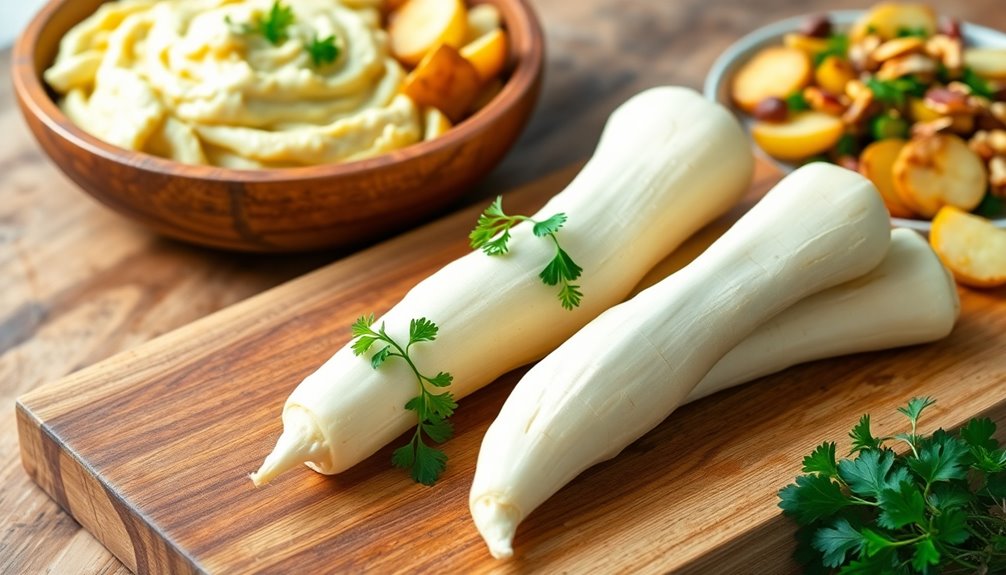
Parsnips are a versatile root vegetable that can elevate your meals with their unique sweetness and texture. If you're looking for recipes using parsnips, you'll find they offer a deliciously low-carb option that fits well into a keto-friendly lifestyle.
Try making crispy parsnip fries; they make a satisfying snack, showcasing a nutty flavor that will surprise your taste buds.
For a delightful side dish, roast parsnips along with carrots—this combination brings out the natural sweetness of both vegetables, enhancing their overall health benefits.
Another great option is smashed parsnips, which serve as a creamy, lower-carb alternative to mashed potatoes. This dish offers a similar texture but packs fewer net carbs.
Feeling under the weather? Whip up a comforting parsnip soup blended with herbs and spices for a warm, nutrient-dense meal.
Finally, consider adding parsnips to your vegetable stir-fries. They not only boost fiber content but also bring a subtle sweetness that balances savory flavors perfectly.
With these recipes, you can enjoy parsnips in various delicious ways while keeping your health goals in check! Additionally, incorporating parsnips into your meals aligns with the trend of minimalist living that emphasizes simplicity and healthy eating.
Frequently Asked Questions
Are Parsnips Ok on a Low-Carb Diet?
If you're following a low-carb diet, parsnips mightn't be the best choice due to their higher carb content.
With about 20.8 grams of net carbs in a typical serving, they can quickly eat into your daily allowance.
However, if you're on a more relaxed low-carb plan, you can enjoy parsnips in moderation.
Just keep an eye on your portions and consider lower-carb alternatives like cauliflower or zucchini for more flexibility.
Do Parsnips Have Less Carbs Than Potatoes?
When you're comparing parsnips and potatoes, you might feel torn between flavors and carbs.
Parsnips actually have slightly more total carbohydrates than potatoes, with about 26.5 grams per cup compared to potatoes' 34 grams.
However, parsnips' net carbs are higher too, making them less ideal for low-carb diets.
So, if you're counting carbs, you may want to choose potatoes.
But remember, both offer unique taste and nutritional benefits!
Do Parsnips Raise Blood Sugar?
Yes, parsnips can raise your blood sugar levels.
They've a moderate glycemic index, which means they can cause a moderate increase in blood sugar when consumed.
A 100-gram serving contains about 18 grams of carbohydrates, with roughly 13.1 grams being net carbs.
If you're watching your glucose, it's important to control your portion size and balance parsnips with lower-carb foods to help manage any potential spikes effectively.
How Many Net Carbs Are in a Parsnip?
You'd think parsnips are just innocent root veggies, but they've got a sneaky side when it comes to carbs!
In a 100-gram serving, you'll find about 13.09 grams of net carbs after factoring in fiber. If you're eyeing a cup of sliced parsnips, brace yourself for around 20.8 grams.
Conclusion
In the garden of nutrition, parsnips stand as a golden root, rich in flavor and health benefits. By understanding their net carb content, you can embrace these versatile vegetables without guilt. As you explore low-carb diets, think of parsnips as your compass, guiding you toward delicious, nourishing meals. So, whether you roast, mash, or add them to soups, let parsnips cultivate a vibrant path to wellness on your plate, reminding you that healthy choices can be both satisfying and enjoyable.
